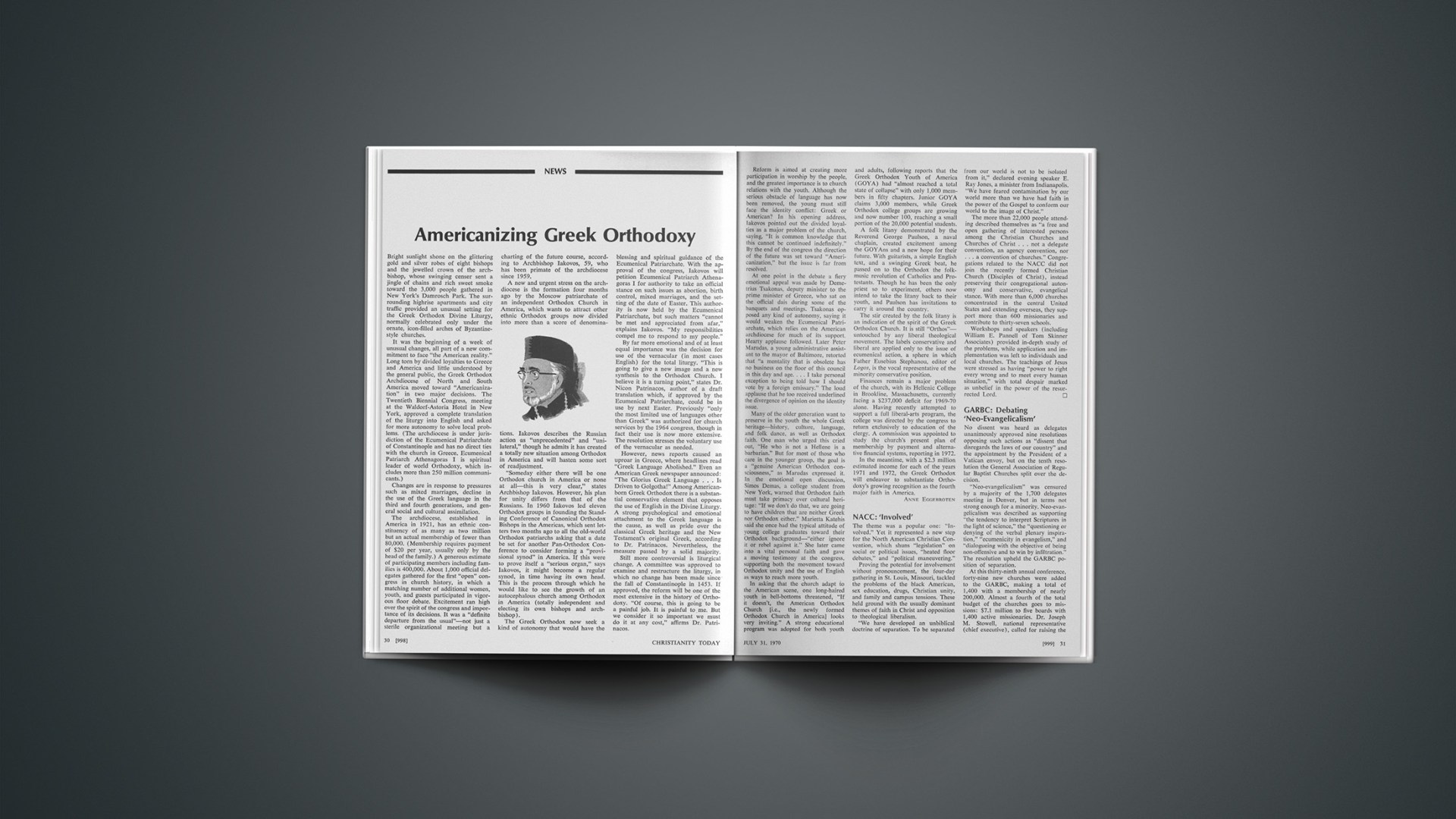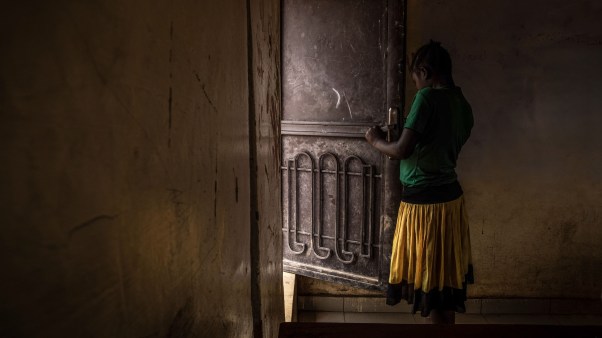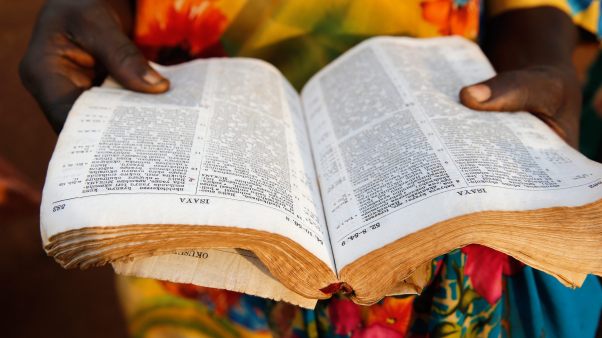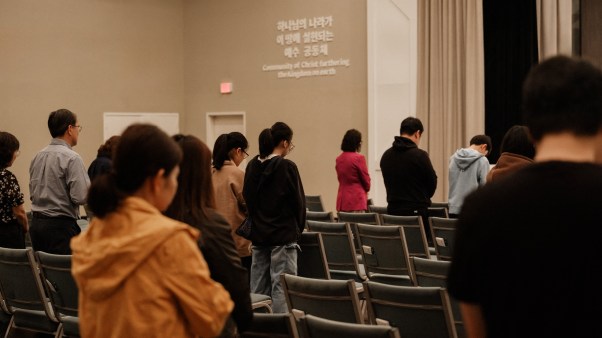Bright sunlight shone on the glittering gold and silver robes of eight bishops and the jewelled crown of the archbishop, whose swinging censer sent a jingle of chains and rich sweet smoke toward the 3,000 people gathered in New York’s Damrosch Park. The surrounding highrise apartments and city traffic provided an unusual setting for the Greek Orthodox Divine Liturgy, normally celebrated only under the ornate, icon-filled arches of Byzantine-style churches.
It was the beginning of a week of unusual changes, all part of a new commitment to face “the American reality.” Long torn by divided loyalties to Greece and America and little understood by the general public, the Greek Orthodox Archdiocese of North and South America moved toward “Americanization” in two major decisions. The Twentieth Biennial Congress, meeting at the Waldorf-Astoria Hotel in New York, approved a complete translation of the liturgy into English and asked for more autonomy to solve local problems. (The archdiocese is under jurisdiction of the Ecumenical Patriarchate of Constantinople and has no direct ties with the church in Greece. Ecumenical Patriarch Athenagoras I is spiritual leader of world Orthodoxy, which includes more than 250 million communicants.)
Changes are in response to pressures such as mixed marriages, decline in the use of the Greek language in the third and fourth generations, and general social and cultural assimilation.
The archdiocese, established in America in 1921, has an ethnic constituency of as many as two million but an actual membership of fewer than 80,000. (Membership requires payment of $20 per year, usually only by the head of the family.) A generous estimate of participating members including families is 400,000. About 1,000 official delegates gathered for the first “open” congress in church history, in which a matching number of additional women, youth, and guests participated in vigorous floor debate. Excitement ran high over the spirit of the congress and importance of its decisions. It was a “definite departure from the usual”—not just a sterile organizational meeting but a charting of the future course, according to Archbishop Iakovos, 59, who has been primate of the archdiocese since 1959.
A new and urgent stress on the archdiocese is the formation four months ago by the Moscow patriarchate of an independent Orthodox Church in America, which wants to attract other ethnic Orthodox groups now divided into more than a score of denominations. Iakovos describes the Russian action as “unprecedented” and “unilateral,” though he admits it has created a totally new situation among Orthodox in America and will hasten some sort of readjustment.
“Someday either there will be one Orthodox church in America or none at all—this is very clear,” states Archbishop Iakovos. However, his plan for unity differs from that of the Russians. In 1960 Iakovos led eleven Orthodox groups in founding the Standing Conference of Canonical Orthodox Bishops in the Americas, which sent letters two months ago to all the old-world Orthodox patriarchs asking that a date be set for another Pan-Orthodox Conference to consider forming a “provisional synod” in America. If this were to prove itself a “serious organ,” says Iakovos, it might become a regular synod, in time having its own head. This is the process through which he would like to see the growth of an autocephalous church among Orthodox in America (totally independent and electing its own bishops and archbishop).
The Greek Orthodox now seek a kind of autonomy that would have the blessing and spiritual guidance of the Ecumenical Patriarchate. With the approval of the congress, Iakovos will petition Ecumenical Patriarch Athenagoras I for authority to take an official stance on such issues as abortion, birth control, mixed marriages, and the setting of the date of Easter. This authority is now held by the Ecumenical Patriarchate, but such matters “cannot be met and appreciated from afar,” explains Iakovos. “My responsibilities compel me to respond to my people.”
By far more emotional and of at least equal importance was the decision for use of the vernacular (in most cases English) for the total liturgy. “This is going to give a new image and a new synthesis to the Orthodox Church. I believe it is a turning point,” states Dr. Nicon Patrinacos, author of a draft translation which, if approved by the Ecumenical Patriarchate, could be in use by next Easter. Previously “only the most limited use of languages other than Greek” was authorized for church services by the 1964 congress, though in fact their use is now more extensive. The resolution stresses the voluntary use of the vernacular as needed.
However, news reports caused an uproar in Greece, where headlines read “Greek Language Abolished.” Even an American Greek newspaper announced: “The Glorius Greek Language … Is Driven to Golgotha!” Among American-born Greek Orthodox there is a substantial conservative element that opposes the use of English in the Divine Liturgy. A strong psychological and emotional attachment to the Greek language is the cause, as well as pride over the classical Greek heritage and the New Testament’s original Greek, according to Dr. Patrinacos. Nevertheless, the measure passed by a solid majority.
Still more controversial is liturgical change. A committee was approved to examine and restructure the liturgy, in which no change has been made since the fall of Constantinople in 1453. If approved, the reform will be one of the most extensive in the history of Orthodoxy. “Of course, this is going to be a painful job. It is painful to me. But we consider it so important we must do it at any cost,” affirms Dr. Patrinacos.
Reform is aimed at creating more participation in worship by the people, and the greatest importance is to church relations with the youth. Although the serious obstacle of language has now been removed, the young must still face the identity conflict: Greek or American? In his opening address, Iakovos pointed out the divided loyalties as a major problem of the church, saying, “It is common knowledge that this cannot be continued indefinitely.” By the end of the congress the direction of the future was set toward “Americanization,” but the issue is far from resolved.
At one point in the debate a fiery emotional appeal was made by Demetrius Tsakonas, deputy minister to the prime minister of Greece, who sat on the official dais during some of the banquets and meetings. Tsakonas opposed any kind of autonomy, saying it would weaken the Ecumenical Patriarchate, which relies on the American archdiocese for much of its support. Hearty applause followed. Later Peter Marudas, a young administrative assistant to the mayor of Baltimore, retorted that “a mentality that is obsolete has no business on the floor of this council in this day and age.… I take personal exception to being told how I should vote by a foreign emissary.” The loud applause that he too received underlined the divergence of opinion on the identity issue.
Many of the older generation want to preserve in the youth the whole Greek heritage—history, culture, language, and folk dance, as well as Orthodox faith. One man who urged this cried out, “He who is not a Hellene is a barbarian.” But for most of those who care in the younger group, the goal is a “genuine American Orthodox consciousness,” as Marudas expressed it. In the emotional open discussion, Simos Demas, a college student from New York, warned that Orthodox faith must take primacy over cultural heritage: “If we don’t do that, we are going to have children that are neither Greek nor Orthodox either.” Marietta Katehis said she once had the typical attitude of young college graduates toward their Orthodox background—“either ignore it or rebel against it.” She later came into a vital personal faith and gave a moving testimony at the congress, supporting both the movement toward Orthodox unity and the use of English as ways to reach more youth.
In asking that the church adapt to the American scene, one long-haired youth in bell-bottoms threatened, “If it doesn’t, the American Orthodox Church [i.e., the newly formed Orthodox Church in America] looks very inviting.” A strong educational program was adopted for both youth and adults, following reports that the Greek Orthodox Youth of America (GOYA) had “almost reached a total state of collapse” with only 1,000 members in fifty chapters. Junior GOYA claims 3,000 members, while Greek Orthodox college groups are growing and now number 100, reaching a small portion of the 20,000 potential students.
A folk litany demonstrated by the Reverend George Paulson, a naval chaplain, created excitement among the GOYAns and a new hope for their future. With guitarists, a simple English text, and a swinging Greek beat, he passed on to the Orthodox the folk-music revolution of Catholics and Protestants. Though he has been the only priest so to experiment, others now intend to take the litany back to their youth, and Paulson has invitations to carry it around the country.
The stir created by the folk litany is an indication of the spirit of the Greek Orthodox Church. It is still “Orthos”—untouched by any liberal theological movement. The labels conservative and liberal are applied only to the issue of ecumenical action, a sphere in which Father Eusebius Stephanou, editor of Logos, is the vocal representative of the minority conservative position.
Finances remain a major problem of the church, with its Hellenic College in Brookline, Massachusetts, currently facing a $237,000 deficit for 1969–70 alone. Having recently attempted to support a full liberal-arts program, the college was directed by the congress to return exclusively to education of the clergy. A commission was appointed to study the church’s present plan of membership by payment and alternative financial systems, reporting in 1972.
In the meantime, with a $2.3 million estimated income for each of the years 1971 and 1972, the Greek Orthodox will endeavor to substantiate Orthodoxy’s growing recognition as the fourth major faith in America.
ANNE EGGEBROTEN
Nacc: ‘Involved’
The theme was a popular one: “Involved.” Yet it represented a new step for the North American Christian Convention, which shuns “legislation” on social or political issues, “heated floor debates,” and “political maneuvering.”
Proving the potential for involvement without pronouncement, the four-day gathering in St. Louis, Missouri, tackled the problems of the black American, sex education, drugs, Christian unity, and family and campus tensions. These held ground with the usually dominant themes of faith in Christ and opposition to theological liberalism.
“We have developed an unbiblical doctrine of separation. To be separated from our world is not to be isolated from it,” declared evening speaker E. Ray Jones, a minister from Indianapolis. “We have feared contamination by our world more than we have had faith in the power of the Gospel to conform our world to the image of Christ.”
The more than 22,000 people attending described themselves as “a free and open gathering of interested persons among the Christian Churches and Churches of Christ … not a delegate convention, an agency convention, nor … a convention of churches.” Congregations related to the NACC did not join the recently formed Christian Church (Disciples of Christ), instead preserving their congregational autonomy and conservative, evangelical stance. With more than 6,000 churches concentrated in the central United States and extending overseas, they support more than 600 missionaries and contribute to thirty-seven schools.
Workshops and speakers (including William E. Pannell of Tom Skinner Associates) provided in-depth study of the problems, while application and implementation was left to individuals and local churches. The teachings of Jesus were stressed as having “power to right every wrong and to meet every human situation,” with total despair marked as unbelief in the power of the resurrected Lord.
Garbc: Debating ‘Neo-Evangelicalism’
No dissent was heard as delegates unanimously approved nine resolutions opposing such actions as “dissent that disregards the laws of our country” and the appointment by the President of a Vatican envoy, but on the tenth resolution the General Association of Regular Baptist Churches split over the decision.
“Neo-evangelicalism” was censured by a majority of the 1,700 delegates meeting in Denver, but in terms not strong enough for a minority. Neo-evangelicalism was described as supporting “the tendency to interpret Scriptures in the light of science,” the “questioning or denying of the verbal plenary inspiration,” “ecumenicity in evangelism,” and “dialogueing with the objective of being non-offensive and to win by infiltration.” The resolution upheld the GARBC position of separation.
At this thirty-ninth annual conference, forty-nine new churches were added to the GARBC, making a total of 1,400 with a membership of nearly 200,000. Almost a fourth of the total budget of the churches goes to missions: $7.1 million to five boards with 1,400 active missionaries. Dr. Joseph M. Stowell, national representative (chief executive), called for raising the number of missionaries to 2,000 in the 1970s, as well as establishing up to 1,000 new churches, doubling the literature ministry, and tripling the radio ministry.
As usual, the annual conference was devoted mainly to spiritual edification in sermons, workshops, and fellowship, with about one half hour a day spent on the business of resolutions.
Brethren Commend Draft Resistance
A “peace church” has escalated its battle for peace with a new position: support and commendation for nonviolent draft-resisters.
The Church of the Brethren voted 754 to 103 to approve equally young men choosing open non-cooperation and those choosing alternative service. The decision came at the annual conference last month in Lincoln, Nebraska, after four hours of sometimes sharp debate and an attempt to postpone action. Backing for draft-resisters had been discussed but not approved at last year’s meeting.
An ongoing program to fight racism and aid minority development was also approved with $100,000 support assured for next year.
Urging members to divorce themselves from employment and investment related to defense industries, the new policy statement on war asserted military recruitment on Brethren college campuses to be inconsistent with the church’s historic declaration against war since its founding in 1708.
The 200,000-member body pledged itself “to use its influence to abolish or radically restructure the system which conscripts persons for military purposes.”
A Pearl Of Great Price
“I am very happy to be breathing free air again,” said American bishop James E. Walsh after twelve years in a Communist Chinese prison. The 79-year-old Maryknoll missionary was arrested by the Communist government in 1958, and sentenced to twenty years in jail on charges of spying. After eighteen months of interrogation he “confessed.”
Walsh, the last Catholic missionary to leave China, was placed in a hospital to recuperate after he was unexpectedly led across the border into Hong Kong July 10. The official Peking news agency, depicting the bishop as a “convicted imperialist spy,” said he had been released because of his advanced age and poor health.
Father John McCormack, superior-general of the Maryknoll Order, flew to Hong Kong to meet Walsh. After the bishop fully recovered, McCormack was to escort him to Rome for an audience with Pope Paul, and then to his home town of Cumberland, Maryland. “I found no bitterness in him,” reported McCormack. “He is surprisingly gentle and kind toward the people who imprisoned him even though he feels that the severity of his sentence was entirely unjustified.”
Meanwhile, in a cable, the pontiff told Walsh: “With great joy we have received the news of your liberation. Assuring you of our constant prayer, we send you our warmest greetings in Christ Jesus.…” In his prison isolation, Walsh did not even know that Pope John XXIII had died, and he reacted with surprise when told upon release that the United States had recently landed men on the moon.
There were nine children in the Walsh family; two became Maryknoll missionaries to China, and two became nuns. James Walsh entered the newly founded Maryknoll society in 1912—the second of its six original students—and was ordained in 1915.
Since October 3, 1969, Communist Chinese authorities have freed fourteen Britons, seven West Germans, six Japanese, and three Americans, including Walsh, according to United Press International. Twenty other prisoners, including four Americans, are believed to be still incarcerated. Hope for the release of some brightened with the freeing of Walsh.
The bishop refused to leave China after the Communists won power in 1949. He continued to say Mass and publish religious pamphlets as the Peking government escalated its opposition to Christians.
“The task of a missioner,” Walsh once wrote from China, “is to go to a place where he is not wanted, to sell a pearl, whose value, although of great price, is not recognized, to people determined not to accept it even as a gift.…”
Cumberland Presbyterians: Tenuous Ecumenical Ties
The Cumberland Presbyterian General Assembly voted 75–30 to retain partial links with the National Council of Churches. Three of the church’s boards have been involved with NCC agencies. An earlier motion to sever the ties was defeated 65–45.
The assembly, held in Knoxville, Tennessee, took action that provides for one youth delegate from each presbytery and gives youth participation privileges but not the right to vote.
The Cumberland Presbyterian Church has some 65,000 members in fifteen states, mostly in the South.
Dr. L. C. Waddle, campus minister and associate professor of religion at Bethel College in McKenzie, Tennessee, was elected moderator of the assembly.
Victory For Aba
Victory—both spiritual and military—was on the minds of members of the American Baptist Association during a three-day convention last month in Louisville, Kentucky.
Resolutions were passed expressing “support for the President of the United States in his quest to bring the war he inherited to a successful end” and calling for special prayer for the President and the armed forces.
“Win the lost at any cost” was the motto offered by Dr. Corbett Mask, ABA president, and strongly proclaimed in the two major sermons on evangelism and missions.
Dr. Mask also urged that “instead of playing party politics with this Viet Nam war we should be praying for our beloved President that he would be aided by that Divine Providence that has guided America through all of her wars and brought her victory.”
The ABA includes perhaps 4,000 “fundamental, independent, missionary Baptist churches,” largely in the South.
Lutheran Sex Code: Covenant Above Contract
A barrage of applause punctuated the end of an impassioned plea by Minnesota governor and Lutheran Church in America biennial convention delegate Harold LeVander when he warned fellow delegates in Minneapolis: “We are saying that the laws of fornication are going to be wiped off the books.… We are proposing to reestablish common-law marriages.…”
Governor LeVander and his brother, Bernard, an attorney and member of the denominational Executive Council, along with others opposed to the LCA’s liberal new statement on “Sex, Marriage, and the Family,” did manage to get an amendment added to the controversial document on the sixth of seven days of debate. But the basic provisions of the 2,200-word position paper were approved intact the following day (see News, July 17 issue, page 33).
The amendment, inserted under a subhead rather than in the preamble as originally voted, notes: “Because the Lutheran Church in America holds that sexual intercourse outside the marriage union is morally wrong, nothing in this statement … is to be interpreted as meaning that this church either condones or approves pre-marital or extramarital sexual intercourse.”
Drafters of the statement (an official ten-member committee worked on it for four years) nonetheless said the document could be interpreted as permitting sexual intercourse outside legal marriage for two persons intending a lifelong commitment to each other.
Most of the sharp debate on the section on “sexual expression” turned on just what such a lifelong commitment might be and what form it might take.
Dr. Paul M. Orso, a member of the LCA Board of Social Ministry, which commissioned the document, said the basic stance of the statement would allow a sexual relationship between a married person and someone other than his or her spouse as long as a “covenant of fidelity” was made between the two partners—even though a legal marriage contract with a husband or wife was still binding. This could happen, he explained, if, for example, legal or personal reasons prevented a divorce and the covenant of fidelity had deteriorated in the legal marriage.
The final version of the section on homosexuality turned out to be more liberal than the original presented to the convention. Homosexual activity is said to be a “departure from the heterosexual structure of God’s creation” (the original used the word “deviation”). “Persons who engage in homosexual behavior are sinners only as are all other persons.…” Floor attempts to introduce amendments suggesting that homosexuals needed to be cured through medical or spiritual help were roundly defeated.
On abortion, the statement notes that “the evangelical ethic” permits a woman or couple to “decide responsibly to seek an abortion.” Although admitting that the fetus is “the organic beginning of human life” and that the “termination of its development is always a serious matter,” the document concludes that a qualitative distinction must nevertheless be made “between its claims and the rights of a responsible person made in God’s image who is in living relationships with God and other human beings.”
Time ran out before the convention could deal with the question of whether to use the title “bishop” for the presidents of the denomination’s thirty-three synods. The matter was referred to the Executive Council.
Without debate, the delegates approved denominational budgets of $33,197,800 for 1971 and $33,790,100 for 1972; this year’s budget is $32,510,800.
RUSSELL CHANDLER










